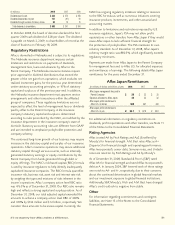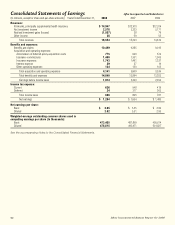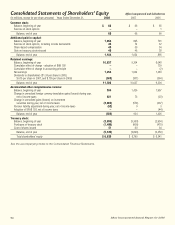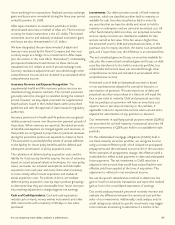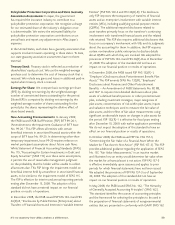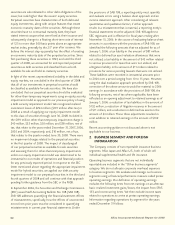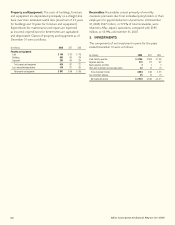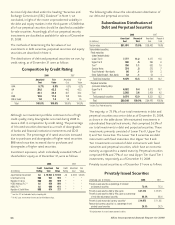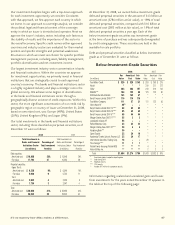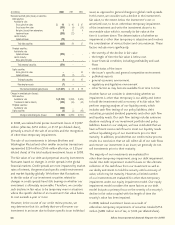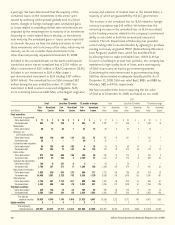Aflac 2008 Annual Report Download - page 65
Download and view the complete annual report
Please find page 65 of the 2008 Aflac annual report below. You can navigate through the pages in the report by either clicking on the pages listed below, or by using the keyword search tool below to find specific information within the annual report.
61
It’s no mystery how Aflac makes a difference.
valuations reflect quoted market prices for identical assets or
liabilities in active markets. Level 2 valuations reflect quoted
market prices for similar assets or liabilities in an active
market, quoted market prices for identical or similar assets or
liabilities in non-active markets or model-derived valuations in
which all significant valuation inputs are observable in active
markets. Level 3 valuations reflect valuations in which one or
more of the significant valuation inputs are not observable in
an active market.
This standard applies to other accounting pronouncements
that require or permit fair value measurements, the
FASB having previously concluded in those accounting
pronouncements that fair value is the relevant measurement
attribute. Accordingly, SFAS 157 does not require any new fair
value measurements. Where applicable, this standard codifies
related guidance within GAAP. SFAS 157 is effective for fiscal
years beginning after November 15, 2007. We adopted the
provisions of SFAS 157 as of January 1, 2008. The adoption of
this standard did not have an impact on our financial position
or results of operations.
In June 2006, the FASB issued FASB Interpretation No. 48
(FIN 48), Accounting for Uncertainty in Income Taxes, an
Interpretation of FASB Statement No. 109. The provisions
of FIN 48 clarify the accounting for uncertainty in income
taxes recognized in an enterprise’s financial statements in
accordance with SFAS No. 109, Accounting for Income Taxes.
FIN 48 prescribes a recognition threshold and measurement
attribute for the financial statement recognition and
measurement of a tax position taken or expected to be taken
in a tax return. The evaluation of a tax position in accordance
with FIN 48 is a two-step process. Under the first step, the
enterprise determines whether it is more likely than not that
a tax position will be sustained upon examination by taxing
authorities. The second step is measurement, whereby a tax
position that meets the more-likely-than-not recognition
threshold is measured to determine the amount of benefit
to recognize in the financial statements. The tax position is
measured at the largest amount of benefit that is greater than
50% likely of being realized upon ultimate settlement. FIN 48
also provides guidance on derecognition, classification, interest
and penalties, accounting in interim periods, disclosure,
and transition. We adopted the provisions of this standard
effective January 1, 2007. The adoption of this standard did
not have any impact on our financial position or results of
operations (see Note 8).
In September 2005, the Accounting Standards Executive
Committee of the American Institute of Certified Public
Accountants (AICPA) issued Statement of Position (SOP)
05-1, Accounting by Insurance Enterprises for Deferred
Acquisition Costs in Connection with Modifications or
Exchanges of Insurance Contracts (SOP 05-1). SOP 05-1
provides accounting guidance on internal replacements
of insurance and investment contracts other than those
specifically described in SFAS No. 97, Accounting and
Reporting by Insurance Enterprises for Certain Long-Duration
Contracts and for Realized Gains and Losses from the Sale of
Investments. SOP 05-1 is effective for internal replacements
occurring in fiscal years beginning after December 15, 2006,
with earlier adoption encouraged. Retrospective application
of this SOP to previously issued financial statements is not
permitted. We adopted the provisions of this statement
effective January 1, 2007. We have determined that certain
of our policy modifications in both the United States and
Japan that were previously accounted for as a continuation of
existing coverage will be considered internal replacements that
are substantially changed as contemplated by SOP 05-1 and
will be accounted for as the extinguishment of the affected
policies and the issuance of new contracts. The adoption of
this statement increased net earnings in 2007 by $6 million,
or $.01 per diluted share, and was insignificant to our financial
position and results of operations.
Securities and Exchange Commission (SEC) Guidance:
On October 14, 2008, the SEC issued a letter to the FASB
addressing recent questions raised by various interested
parties regarding declines in the fair value of perpetual
preferred securities, or so-called “hybrid securities,” which
have both debt and equity characteristics and the assessment
of those declines under existing accounting guidelines for
other-than-temporary impairments. In its letter, the SEC
recognized that hybrid securities are often structured in equity
form but generally possess significant debt-like characteristics.
The SEC also recognized that existing accounting guidance
does not specifically address the impact, if any, of the debt-like
characteristics of these hybrid securities on the assessment of
other-than-temporary impairments.
After consultation with and concurrence of the FASB staff,
the SEC concluded that it will not object to the use of an
other-than-temporary impairment model that considers
the debt-like characteristics of hybrid securities (including
the anticipated recovery period), provided there has been
no evidence of a deterioration in credit of the issuer (for
example, a decline in the cash flows from holding the
investment or a downgrade of the rating of the security below
investment grade), in filings after the date of its letter until the
matter can be addressed further by the FASB.
We maintain investments in subordinated financial
instruments, or so-called “hybrid securities.” Within this class
of investments, we own perpetual securities. These perpetual


